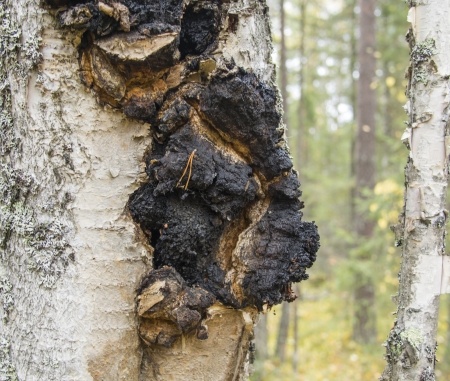Chaga Mushroom – Inonotus obliquus

Common Names: Chaga, Chaga Mushroom, Birch Mushroom, Black Mass, Clinker Polypore, Inonotus obliquus, Chaga Fungus, Tschaga, Cinder Conk, Schiefer Schillerporling, Sterile Conk, Global: Chaga, English: Chaga Mushroom, Latin: Inonotus obliquus, Russian Origin: Čaga, Sibiryak
Latin Name: Inonotus obliquus
Origin: Asia, Europe, South America, North America
Short Introduction
Because this fungus naturally thrives in extremely harsh and challenging environments, there are no standard cultivation conditions that guarantee consistent levels of its active compounds. Chaga grows in very cold climates, develops slowly, and its composition varies widely, making it difficult to achieve stable concentrations of its constituents. Even among genetically similar varieties, researchers have found notable differences in secondary metabolite content—sometimes a deficiency or even total absence in certain compounds. Marked differences have especially been observed in ergosterol metabolites within this species, which depend on the substrate it grows on. When chaga ‘parasitizes’ birch trees (its typical natural habitat), it contains high amounts of betulin, which the fungus converts into betulinic acid—an active ingredient more readily processed by the human body.
Detailed Description
A medicinal mushroom with potent anti-cancer and immune-boosting effects, chaga has been cherished in Russian folk medicine for over four centuries.
Botanical Information
Chaga is a parasitic fungus that most commonly infects birch trees, though it can also be found on other trees. This mushroom is easily recognized by its irregular, coal-black appearance caused by a high concentration of the pigment melanin. Chaga prefers to grow on living hardwoods (mainly birch), but can occasionally be spotted on dead or dying trees. Its fruiting body typically measures 10–30 cm wide and can reach up to 50–90 cm in height.
Origin and Distribution
Chaga originated in the Russian taiga and later spread to Korea, northern China, North America (along the northern border of the USA and throughout Canada), as well as northern and eastern Europe. Even in its main regions of occurrence, chaga is rare and considered a unique find. Its rarity is compounded by the fact that high-quality fruiting bodies are typically 20–25 years old.
Usage / Dosage
Throughout many cultures, chaga is collected and used in traditional medicine as a folk remedy for a diverse range of ailments. It has been used in Russia and Siberia since the late 16th century. Traditionally, chaga is recommended for cancer, cardiovascular issues, and diabetes. Its healing effects are primarily attributed to its high concentration of melanin, a powerful antioxidant found in the mushroom. Recent scientific studies have begun to focus on its antioxidant, chemotherapeutic, and anti-inflammatory properties. We already know that chaga positively modulates inflammation mediators and interleukins, acting like 'magnets' for immune system 'scavenger' cells—though more studies are needed to clarify the precise impact. During anti-cancer therapies involving chaga, it is advised to avoid fatty foods, processed meats, and alcohol.
Chaga also benefits digestive and stomach issues after just a few weeks of regular use. It strengthens the tone of smooth muscles in the digestive tract and enhances intestinal peristalsis. In general oncology, chaga is known for its strong effect against gastrointestinal tumors. It is also highly effective for chronic gastritis, stomach (and duodenal) ulcers, as well as liver and gallbladder diseases. Chaga is a valuable supportive treatment for ulcerative colitis and Crohn's disease.
Chaga exerts significant effects on conditions related to the lymphatic system and lymphatic circulation disorders. It also helps with skin barrier regeneration and the restoration of the skin’s protective properties. On a molecular level, chaga restores metabolic harmony and increases the body’s resilience by strengthening immune system responses.
Active Compounds
Chaga contains a range of secondary metabolites, including phenol derivatives (melanins), secondary alcohols, and triterpenes such as betulinic acid (a betulin precursor), inotodiol, and obliquol. It also provides polysaccharides, steroidal compounds, and purines. Chaga-specific acid is known to act directly on the immune system and is thought to be the most significant immune stimulant. Among its mineral content, manganese, cobalt, and selenium are notable for their immunostimulatory and immunomodulatory effects. The melanin pigment is particularly important for its health benefits.
Traditional Dosage
Chaga is traditionally prepared in powdered form, which can be easily mixed into water- or alcohol-based solutions or processed into capsules. It can be consumed on its own or added to other flavored beverages. The classic Russian remedy involves simmering chaga in hot water (‘zavarka’).
The most common and affordable method is to prepare a traditional tea using a water extract. This solution contains all water-soluble compounds. Fat-soluble substances like phytosterols, betulin, and betulinic acid are absent from this method, but polysaccharides (especially D-glucans) are present, playing a key role in activating the immune system. Pharmaceutical processing can further enhance these beneficial compound concentrations.
Ethanol extraction or fermentation may also be used to create chaga products. Most supplements contain extracts prepared with both water and alcohol. For general prevention, the typical dosage is 1 teaspoon (about 1g) of concentrated chaga extract daily. For more serious concerns, this preventive dose can be doubled, and in cases of cancer, even tripled. The maximum recommended daily dose for severely weakened individuals is about 5g. Noticeable effects typically occur after 3–6 months, but regular, consistent use is required. Optimal results are achieved with at least 12 months of continual usage.



